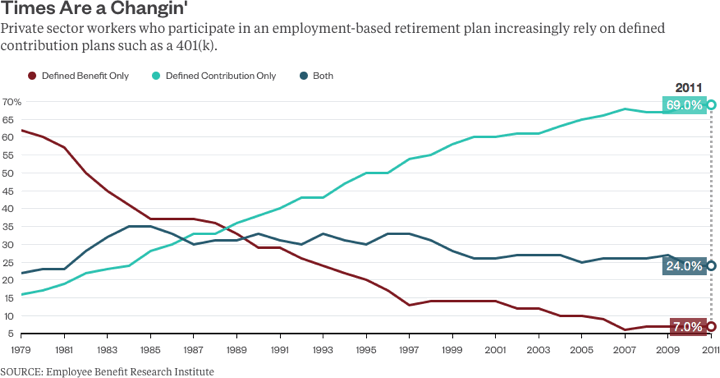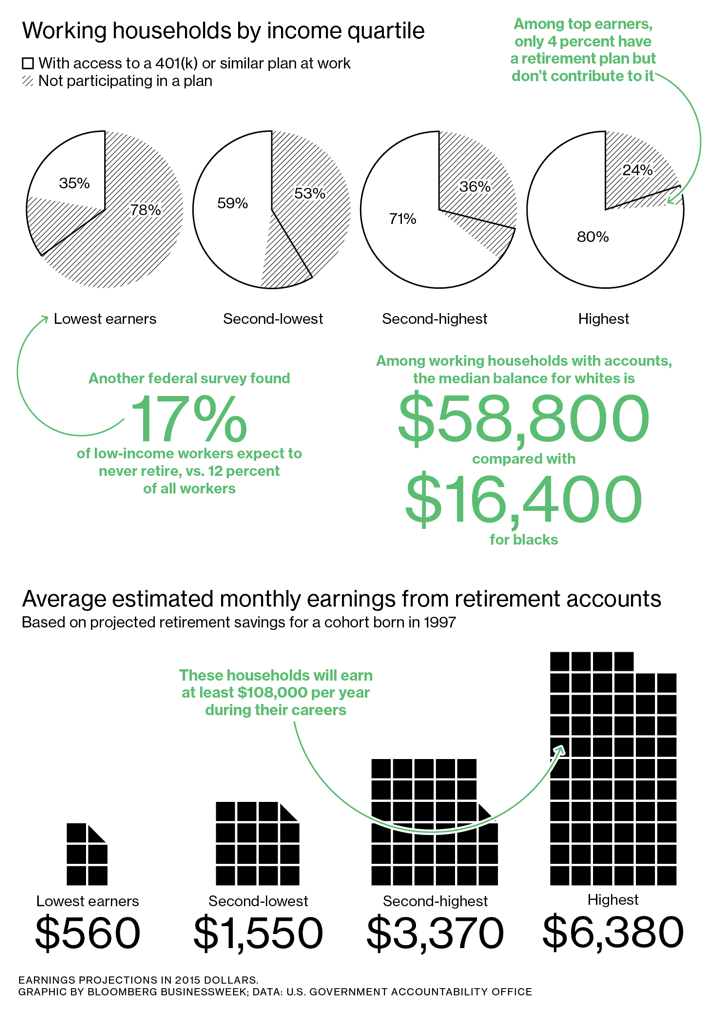As we pass the halfway mark of this year, it was time for my quarterly check-in on my 401(k) account. The best-case scenario for a 401(k) plan is:
- Company match. A little extra help from your employer is always nice.
- Good default settings. The set-up process should be easy and completely painless. Ideally, you should be automatically opted-in for a some level of savings into a a diversified, low-cost option.
- Low-cost investment choices. The less you pay, the more you keep.
- Low account fees. Ditto.
For more and more Americans, the 401(k) is their primary vehicle for retirement. Here’s a good visualization from Bloomberg about the year-by-year decline of pensions (defined-benefit) and the rise of 401/403b/similar (defined-benefit) plans.

Here’s another infographic from Bloomberg comparing income level, the availability of a 401(k) or similar plan, and the actual participation rate in such a plans.

The higher the income, the more likely you have access to a 401(k) or similar plan. In the highest-paid quartile, 96% of people with the option do participate. Not too surprising. The most interesting takeaway was that even in the lowest income quartile, if you offer a 401(k) plan, the majority of people will participate! The sad part is that only 35% of the lowest income quartile are even given the option.
Improving all the factors I listed first above (company match, lower fees) is still a good thing and is often talked about. However, it would seem like the best thing would be to widen the availability of such an option to everyone. This was probably the thinking behind the creation of myRA, but behaviorally there are still too many obstacles to signing up for the program. It still requires work and opt-in with no immediate benefit. There’s a reason why there are always sign-up bonuses for bank accounts – filling out applications is tedious.
If every time I was harassed to switch to paperless statements with “just one click”, someone was instead harassed into setting up a retirement plan with auto-contributions with “just one click”, there would be a lot more savings.
 The Best Credit Card Bonus Offers – March 2024
The Best Credit Card Bonus Offers – March 2024 Big List of Free Stocks from Brokerage Apps
Big List of Free Stocks from Brokerage Apps Best Interest Rates on Cash - March 2024
Best Interest Rates on Cash - March 2024 Free Credit Scores x 3 + Free Credit Monitoring
Free Credit Scores x 3 + Free Credit Monitoring Best No Fee 0% APR Balance Transfer Offers
Best No Fee 0% APR Balance Transfer Offers Little-Known Cellular Data Plans That Can Save Big Money
Little-Known Cellular Data Plans That Can Save Big Money How To Haggle Your Cable or Direct TV Bill
How To Haggle Your Cable or Direct TV Bill Big List of Free Consumer Data Reports (Credit, Rent, Work)
Big List of Free Consumer Data Reports (Credit, Rent, Work)
They should also look at whether or not the 401k plan has a match.
If there is no match then it can make sense for fewer people to participate. Roth IRA might be better for someone than a 401k with no match.
Good point, and lower incomes can qualify for the Savers Credit on Roth IRA contributions. So it is interesting that still a majority of people offered the 401k option do take it, even in the lowest quartile.
We should just abolish 401k/403b/457b’s and add the $18k limit to IRAs instead. This would eliminate the issues of having the retirement plan tied to the employer, and the typically awful fees in workplace retirement plans. We could create some type of “holding account” that employees could put paycheck deductions into, that could then easily be transferred out to IRAs (and only IRAs, otherwise a tax penalty is incurred). The employers could also verify that the employee put in enough for a match, and then deposit the match into this holding account. If the employer has a vesting schedule for the match, then the matched money would be stuck in the holding account until vested.
But alas, this will never happen.
Been following your blog for past year and love the content and perspectives offered. On this topic, I wanted to get your take on Andy Tanner’s book 401k chaos which offers a scaring take on defined contribution plans. I found it at http://nielsenconsulting.net/wp-content/uploads/Andy-Tanner-401kaos-Book.pdf
A brief skim suggests to me that the book is mostly about selling you on the idea of paying for Rich Dad Poor Dad classes, which in my opinion are overpriced and not worth it. I haven’t been impressed with any recent Rich Dad-sponsored books.